Stabilizing sexual selection for female ornaments in a dance fly


Jill’s paper is the “editor’s pick” in the most recent edition of the Journal of Evolution Biology. Ornamental traits (e.g. the peacock's tail) in males are presumed to experience directional sexual selection (larger ornaments attract more mates). Ornaments are rare in females but are found in some dance flies such as Rhamphomyia longicauda (Diptera: Empididae). Females of this species - found locally in the Credit Valley, including the Gwynne backyard - swarm and attract males with elaborate inflated abdominal sacs (See left photo, credit: G. Wizen) and legs adorned with large scales. A theoretical model predicts that female ornaments may be under stabilizing selection because large ornaments may be constrained by fecundity costs whereas small ornaments attract few males. Jill’s analysis provides the first tentative support for stabilizing selection on the fly ornaments, while finding no evidence for directional selection.
Jill is now the coordinator for first year labs in EEB, St. George. Congratulations, Jill!
